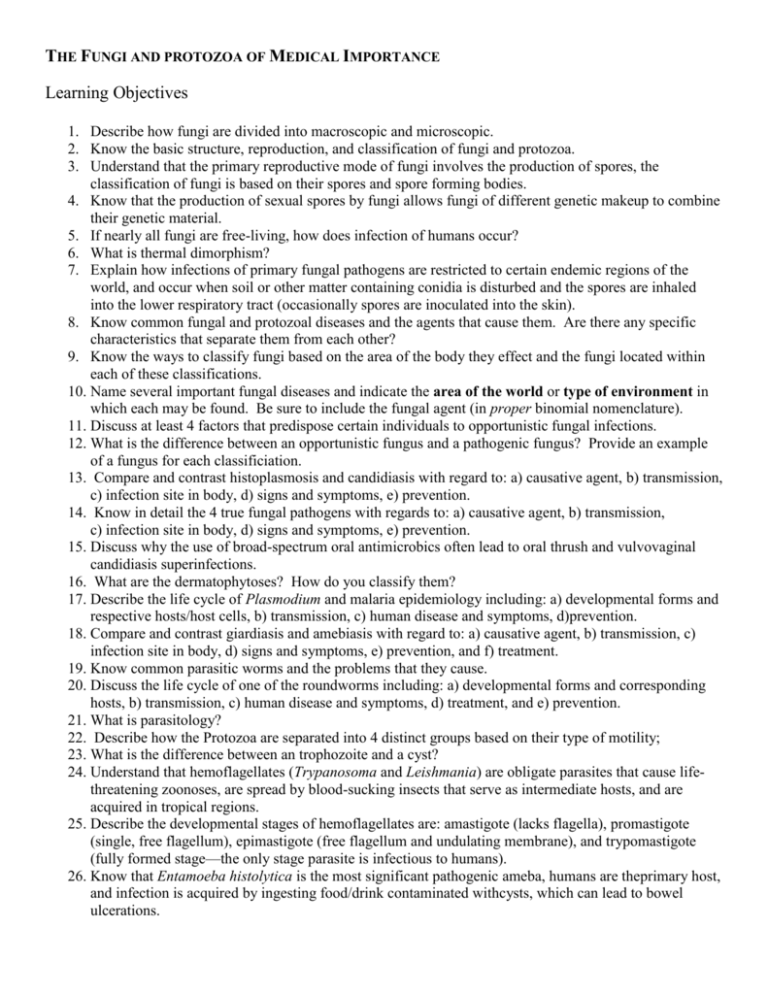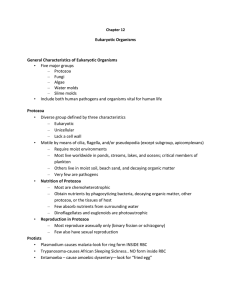chapter 22 the fungi of medical importance
advertisement

THE FUNGI AND PROTOZOA OF MEDICAL IMPORTANCE Learning Objectives 1. Describe how fungi are divided into macroscopic and microscopic. 2. Know the basic structure, reproduction, and classification of fungi and protozoa. 3. Understand that the primary reproductive mode of fungi involves the production of spores, the classification of fungi is based on their spores and spore forming bodies. 4. Know that the production of sexual spores by fungi allows fungi of different genetic makeup to combine their genetic material. 5. If nearly all fungi are free-living, how does infection of humans occur? 6. What is thermal dimorphism? 7. Explain how infections of primary fungal pathogens are restricted to certain endemic regions of the world, and occur when soil or other matter containing conidia is disturbed and the spores are inhaled into the lower respiratory tract (occasionally spores are inoculated into the skin). 8. Know common fungal and protozoal diseases and the agents that cause them. Are there any specific characteristics that separate them from each other? 9. Know the ways to classify fungi based on the area of the body they effect and the fungi located within each of these classifications. 10. Name several important fungal diseases and indicate the area of the world or type of environment in which each may be found. Be sure to include the fungal agent (in proper binomial nomenclature). 11. Discuss at least 4 factors that predispose certain individuals to opportunistic fungal infections. 12. What is the difference between an opportunistic fungus and a pathogenic fungus? Provide an example of a fungus for each classificiation. 13. Compare and contrast histoplasmosis and candidiasis with regard to: a) causative agent, b) transmission, c) infection site in body, d) signs and symptoms, e) prevention. 14. Know in detail the 4 true fungal pathogens with regards to: a) causative agent, b) transmission, c) infection site in body, d) signs and symptoms, e) prevention. 15. Discuss why the use of broad-spectrum oral antimicrobics often lead to oral thrush and vulvovaginal candidiasis superinfections. 16. What are the dermatophytoses? How do you classify them? 17. Describe the life cycle of Plasmodium and malaria epidemiology including: a) developmental forms and respective hosts/host cells, b) transmission, c) human disease and symptoms, d)prevention. 18. Compare and contrast giardiasis and amebiasis with regard to: a) causative agent, b) transmission, c) infection site in body, d) signs and symptoms, e) prevention, and f) treatment. 19. Know common parasitic worms and the problems that they cause. 20. Discuss the life cycle of one of the roundworms including: a) developmental forms and corresponding hosts, b) transmission, c) human disease and symptoms, d) treatment, and e) prevention. 21. What is parasitology? 22. Describe how the Protozoa are separated into 4 distinct groups based on their type of motility; 23. What is the difference between an trophozoite and a cyst? 24. Understand that hemoflagellates (Trypanosoma and Leishmania) are obligate parasites that cause lifethreatening zoonoses, are spread by blood-sucking insects that serve as intermediate hosts, and are acquired in tropical regions. 25. Describe the developmental stages of hemoflagellates are: amastigote (lacks flagella), promastigote (single, free flagellum), epimastigote (free flagellum and undulating membrane), and trypomastigote (fully formed stage—the only stage parasite is infectious to humans). 26. Know that Entamoeba histolytica is the most significant pathogenic ameba, humans are theprimary host, and infection is acquired by ingesting food/drink contaminated withcysts, which can lead to bowel ulcerations. 27. Understand that Balantidium coli is the only free-living ciliate that establishes infection in humans (usually compromised humans), it colonizes the intestinal mucosa, and can only grow under anaerobic conditions in the presence of the host’s bacterial flora. 28. Discuss the life-cycle of Trichomonads. 29. What protozoa cause STDs? 30. Explain African Sleeping Sickness, its transmission, and manifestations. 31. What do Toxoplasma gondii and pregnancy have to do with each other? 32. Know the fungal and protozoal diseases and agents in detail!!!!











